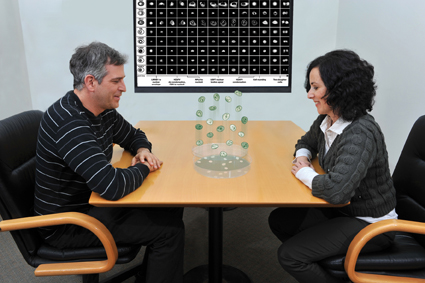Scientists at the Weizmann Institute have developed a kind of huge library, which includes about 1,000 cloned cells, each of which has been inserted into the genome, in the region that codes for the protein, a segment that causes it to glow when it is expressed

Dr. Shiraz Kleer feels differently today when she crosses Science Square on her way to Prof. Uri Alon's laboratory, where she did her doctorate. Today she works at the company "Yeda Research and Development" Ltd., and from a business point of view promotes various inventions born in the laboratories of the institute's scientists. One of these technologies was developed in Prof. Alon's laboratory. "It's a kind of closing of the circle for me, after I was a student in the laboratory at the stage where the idea that eventually led to this large and innovative project was working."
This is a system that is, in fact, a kind of huge library, which includes about 1,000 cloned cells, each of which has been inserted into the genome, in an area that codes for a protein, a section that causes it to glow when it is expressed. In each of the cells it is a different protein, and thus a library of the order of 1,000 proteins was created. The use of a fluorescent marker makes it possible to follow the reactions of individual cells in each of the cloned cell types to changes in the environment. For example, the system makes it possible to examine how the cells (derived from lung cancer tissue) react to potential drug treatments. At the same time, it also makes it possible to link the cell's ability to survive despite the drug treatment designed to kill it, and the expression of various proteins.
The library is accompanied by a software package, which enables automatic monitoring of quantitative protein expression in each of the individual cells and in each of the cell types.
The system was developed in Prof. Alon's laboratory as a tool for research carried out in his research group at the institute, but in fact, it can be used for various purposes, for scientific research in academia and the pharmaceutical industry alike.
The system allows not only to examine the response of the cells to a potential treatment or drug, but also to examine and understand their mechanism of action through the microscopic monitoring of the behavior of the proteins in response to the drug. Understanding the exact mechanism is today a crucial condition in the approval process of new drugs by the American Food and Drug Administration, FDA, whose approval opens the door to the marketing and distribution of new drugs in many countries around the world.
Another advantage is the identification of proteins that behave differently in cells, which survive the drug, and can be used as a target for treatment together with chemotherapy. In this way, it is possible to plan combinations (combinations) between different drugs, each of which activates a different mechanism, or they activate together a mechanism that neither of them activates when acting alone. Such a combination is the basis of the protocol in which the drug "Arbitox" works, which is based on research by Prof. Michael Sela and his research partners at the Weizmann Institute of Science, and currently saves the lives of hundreds of thousands of cancer patients worldwide.
In addition to the scientific response that arose following the publication of various experiments conducted in the library, the technology received great interest from commercial entities. It is currently in the advanced stages of commercialization and collaborations with pharmaceutical companies.
